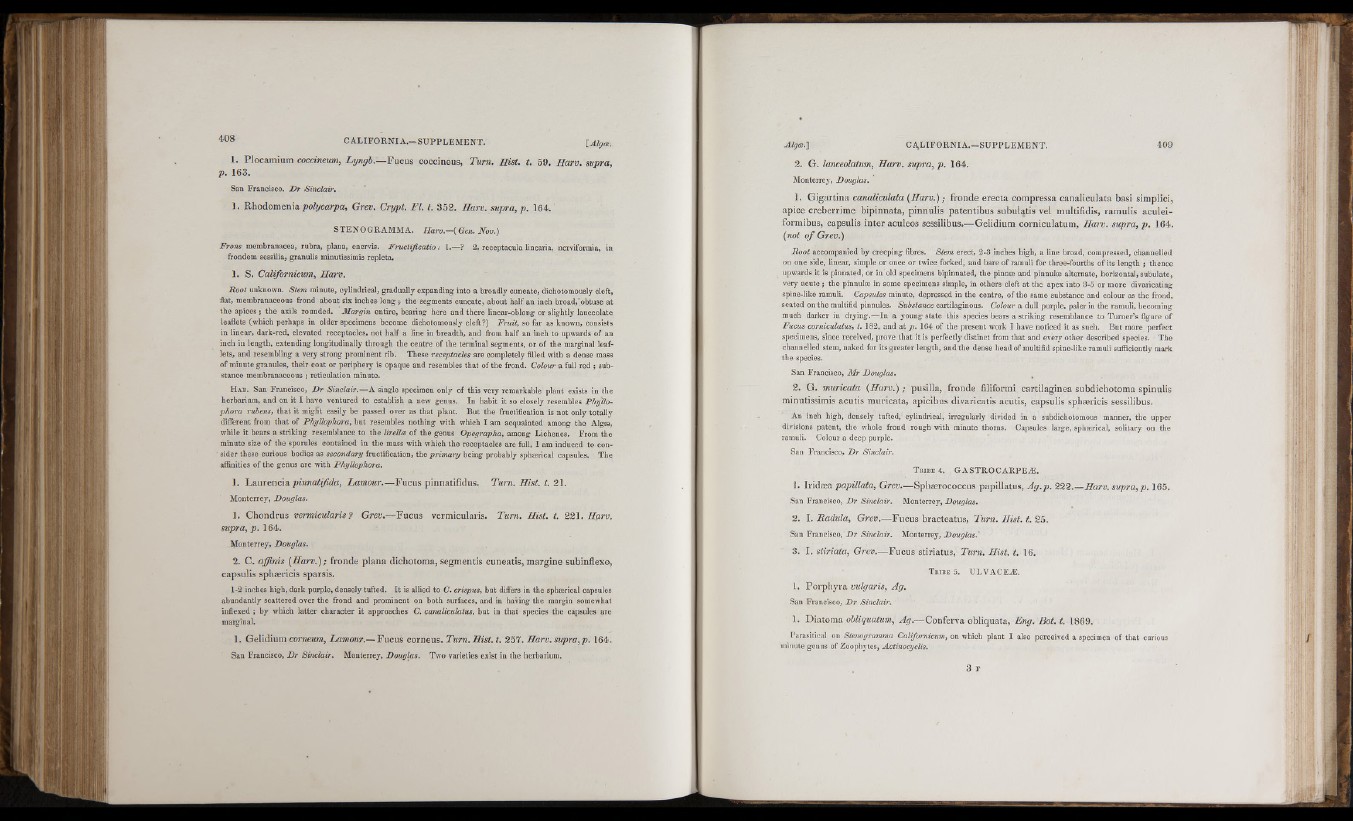
i I
'I 1'
H I,
1. Plocamium coccineum, Lyngb.—Fueus coccineus, Turn. Hist. t. 59. Harv. supra,
p. 163.
San Francisco. D r Sinclair.
1. Rhodomenia/jo/ycar/jc, Grev. Crypt. Fl. t. 3 52. Harv. supra, p. 164.
STENOGRAMMA. Harv.—{Gen. Nov.)
Frons membranacea, rubra, plana, enervis. Fructificatio: 1.—? 2. receptacula linearia, nerviformia, in
frondem sessilia, granulis minutissimis repleta.
1. S. Californicum, Harv.
Root unknown. Stem minute, cylindrical, gradually expanding into a broadly cuneate, dichotomously cleft,
flat, membranaceous frond about six inches long ; the segments cuneate, about half an inch broad,* obtuse at
the apices; the axils rounded. Margin entire, bearing here and there linear-oblong or slightly lanceolate
leaflets (which perhaps in older specimens become dichotomously cleft ?) Fruit, so far as known, consists
in linear, dark-red, elevated receptacles, not half a line in breadth, and from half an inch to upwards of an
inch in length, extending longitudinally through the centre of the terminal segments, or of the marginal leaflets,
and resembling a very strong prominent rib. These receptacles are completely filled with a dense mass
of minute granules, their coat or periphery is opaque and resembles that of the frond. Colour a full red ; substance
membranaceous ; reticulation minute.
H a b . San Francisco, D r Sinclair.— A single specimen only of this very remarkable plant exists in the
herbarium, and on it I have ventured to establish a new genus. In habit it so closely resembles Phyllophora
Tubens, that it might easily be passed over as that plant. But the fructification is not only totally
different from that of Phyllophora, but resembles nothing with which I am acquainted among the Alg®,
while it bears a striking resemblance to the lirellce of the genus Opegrapha, among Lichenes. From the
minute size of the sporules contained in the mass with which the receptacles are full, I am induced to consider
these curious bodies as secondary fructification, the primary being probably sphterical capsules. The
affinities of the genus are with Phyllophora.
1. Juaxxvewcia pinnatifida, Lamour F ucus pinnatifidus. Turn. Hist. t. 21.
Monten'ey, Douglas.
1. C h ondrus vermicularis 9 Grev.—Fucus vermicularis. Turn. Hist. t. 22^. Harv.
supra, p. 164.
Monterrey, Douglas.
2. C. affinis {Harv.); fronde p lan a dichotoma, segmentis c u n e atis,m a rg in e subinflexo,
capsulis sphsericis sparsis.
1-2 inches high, dark purple, densely tufted. It is allied to C. crispus, but differs in the sphmrical capsules
abundantly scattered over the frond and prominent on both surfaces, and in having the margin somewhat
inflexed ; by which latter character it approaches C. canaliculatus, but in that species the capsules arc
marginal.
1. Gelidium corneum, Lamour.— Fucus corneus. Turn. Hist. t. 257. Harv. supra, p. 164-
San Francisco, D r Sinclair. Monterrey, Douglas. Two varieties exist in the herbarium.
Algoe.]
2. G. lanceolatum, Harv.
Monterrey, Douglas.
1. Gigartina canaliculata {Harv.); fronde erecta compressa canaliculata basi simplici,
apice creberrime bipinnata, pinnulis patentibus subulatis vel multifidis, ramulis aculei-
formibus, capsulis in te r acúleos sessilibus.— Gelidium corniculatum, Harv. supra, p. 164.
{not of Grev.)
R oot accompanied by creeping fibres. Stem erect, 2-3 inches high, a line broad, compressed, channelled
on one side, linear, simple or once or twice forked, and bare of ramuli for three-fourths of its length ; thence
upwards it is pinnated, or in old specimens bipinnated, the pinnæ and pinnulæ alternate, horizontal, subulate,
very acute ; the pinnulæ in some specimens simple, in others cleft at the apex into 3-5 or more divaricating
spine-like ramuli. Capsules minute, depressed in the centre, of the same substance and colour as the frond,
seated on the multifid pinnules. Substance cartilaginous. Colour a dull purple, paler in the ramuli, becoming
much darker in drying.—In a young state this speeies bears a striking resemblance to Turner’s figure of
Fucus corniculatus, t. 182, and at p . 164 of the present work I have noticed it as such. But more perfect
specimens, since received, prove that it is perfectly distinct from that and every other described species. The
channelled stem, naked for its greater length, and the dense head of muitifid spine-like ramuli sufficiently mark
the species.
, M r Douglas.
2. G. muricata {Harv.) ; pusilla, fronde filiformi cartilaginea subdichotoma spinulis
minutissimis acutis m uricata, apicibus divarieatis acutis, capsulis spliæricis sessilibus.
An inch high, densely tufted, cylindrical, irregularly divided in a subdichotomous manner, the upper
divisions patent, the whole frond rough with minute thorns. Capsules large, sphærical, solitary on the
ramuli. Colour a deep purple.
San Francisco, D r Sinclair.
T k ib e 4 . GASTROCAR PEÆ.
Ì. Iridæa papillata, Grev— Sphærococcus papillatus, Ag.p. 222.—Harv. supra, p. 165.
San Francisco, Dr Sinclair. Monterrey, Douglas.
2. I. Radula, Grev.— F ucus bracteatus, Turn. Hist. t. 25.
San Francisco, D r Sinclair. Monterrey, Douglas.'
3. I . stiriata, Grev.— Fucus stiriatus, Turn. Hist. t. 16.
T r i b e s . ULVACEÆ.
1. Voiffiiyra vulgaris, Ag.
San Francisco, D r Sinclair.
1. Diatoma Ag.— Conferva obliquata, Eng. Bot. t. 1869.
Parasitical on Stenogramma Californicum, on which plant I also perceived a specimen of that curious
minute genus of Zoophytes, Actinocyclis.